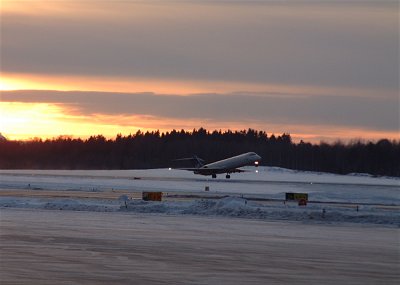6. TAKEOFF.

The final part of the TAXI checklist is completed when we have about one minute
to takeoff. At first contact with the tower, we receive
Line up in sequence. The Swiss Embraer is in front of us and we may line up
as soon as he is rolling.
- 1. Cabin - WARNED.
- Seatbelt sign ON/OFF.
- 2. Spoilers - ARMED.
- Spoilers armed for takeoff.
- 3. Autobrakes - T.O & ARMED
- 4. Takeoff data - CHECKED.
- Check that data agree with actual weights and takeoff position. Review
V1 for go/no go decision.
- 5. Elevator control check - AS REQUIRED.
- An elevator check shall be performed after de-/anti-ice treatment.
The tower gives us clear for takeoff. When lined
up on the runway, a check of compass is done and the controls are handed to the
copilot. On this leg the right pilot will act as PF (Pilot Flying) and the left
pilot as PNF(Pilot Not Flying). That is: all radio communication will be handled
by the PNF while the PF will control the aircraft. As long as the autopilot is not
engaged, the setting of navaids will be done by the PNF, on request by the PF.
 This is the FLIGHT GUIDANCE CONTROL PANEL set for takeoff.
This is the FLIGHT GUIDANCE CONTROL PANEL set for takeoff.
|

The ND showing the initial part of the SID.
| 
The TARP.
Thrust set to FLEX 50.
5000 ft armed.
TAK OFF in both ROLL and PITCH window.
|
Normal takeoff procedure.
The takeoff can be done in two ways:
- Rolling takeoff may be performed except for conditions requiring
a Static takeoff.
- The engine acceleration and readings are done during initial takeoff roll.
- Static takeoff Shall be performed for any of the following conditions
- - Actual TOW is limited by runway length or obstacle.
- - Visibility/RVR at or close to takeoff minima.
- - Contaminated runway.
The static takeoff procedure implies engine acceleration check before brake release.
Advance throttles to 1.4 EPR if runway conditions permit. Check engines for normal
acceleration and check engine instruments for normal readings.
PF will advance the throttles to EPR 1.4, check that the engines responds and
call for "Auto throttle on" while continue to advance the throttles towards takeoff
thrust, then call "Set thrust". PNF will check thrust to be set to selected value,
check all engine instruments readings and that "CLMP" to be announced on FMA, then
call "Thrust set, instruments checked, Clamp".
From there on, it is always left pilot who takes the throttles, regardless off
being PNF or PF. The decision to "GO or STOP" due to possible malfunction during
takeoff rests on the commander. In case of an aborted takeoff, the commander calls
"STOP" and take over the controls. The throttles should be moved into idle revers
(this will cause the ground spoilers to extend and thus the auto brakes to activate).
PNF calls for V1 and rotate. PF should start to rotate the aircraft at
a rate of approximately 3°/sec, to reach lift-off attitude after 2-3 sec.
Then continue rotation and follow FD pitch command bar to initial climb out
attitude.
|

 This is the FLIGHT GUIDANCE CONTROL PANEL set for takeoff.
This is the FLIGHT GUIDANCE CONTROL PANEL set for takeoff.

